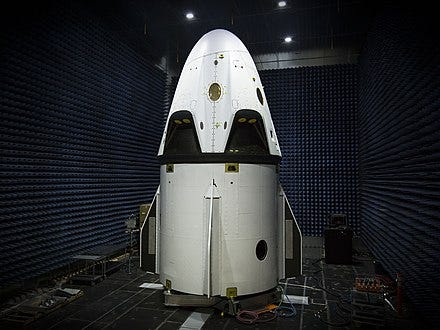SpaceX Part I: A Brief Introduction
Estimated Reading Time: 7 minutes
TL;DR
Today’s subscriber post starts our deep dive into SpaceX, one of the world’s most influential private companies. SpaceX has pioneered reusable rocket landers, and has embarked on ambitious plans to create interplanetary spaceships (Starship) and launch a space-based internet service (Starlink). SpaceX has pioneered new ground in both business and rocketry, walking a narrow path between public contracts and private equity all while holding out the dream of one day colonizing Mars to motivate its engineers and fans.
A Brief History of SpaceX
Elon Musk founded SpaceX in 2002 after failing to purchase cheap rockets from Russia (source). Famously, SpaceX has made a number of unique strategic choices, including using vertical integration, and off the shelf components to the degree possible. SpaceX’s first rocket, the Falcon 1 (see below) was developed primarily with $100 million of Musk’s personal capital (source). The first three launches of the Falcon 1 between 2006-2008 all failed, but the fourth launch in September 2008 went off successfully. NASA awarded a commercial resupply services (CRS) contract to SpaceX on the strength of its results, providing SpaceX the capital it needed to get off the ground.

After the success of the Falcon 1, SpaceX moved to the development of the Falcon 9, a reusable heavy rocket. The Falcon 9 first stage achieved the remarkable milestone of landing autonomously on a floating drone ship in April 2016 (see image below). The spectacle of the Falcon 9’s landing captivated audiences around the world. The Falcon 9 has been used to deliver the Crew Dragon (see second image below) aircraft to the space shuttle with astronaut passengers.


SpaceX has embarked on some extremely ambitious new projects: the Starship heavy-lift launch system (see first image below) which SpaceX plans to use to go to the moon and eventually to Mars, and Starlink, a space based satellite internet system (see second image below).


Rocket Engines
SpaceX has achieved a number of milestones in rocket engine design, including the design of the first commercial liquid fueled rocket engine to reach space (source). SpaceX’s new Raptor engines (see below), have attained world record internal chamber pressures of 330 bar (source).

Governmental Contracts and Private Capital
SpaceX has grown step by step through procuring larger and larger contracts from different federal agencies, largely from NASA but also from the air force and the space force. Governmental capital has proved a powerful form of funding to SpaceX, allowing the company to remain private. The government’s investment in SpaceX has in a sense paid off though: as of 2020, SpaceX had succeeded in capturing 70% of the commercial space launch market, a powerful geopolitical advantage for the US government (source).
It is important to note that SpaceX has also continued to tap private markets for capital, raising billions in investment from private investors largely on the strength of its awarded public contracts. SpaceX’s skillful maneuvering between private and public markets has been a powerful driver of its growth and success.
Mars
One of the founding goals of SpaceX has been to enable human colonization of Mars. The dream of Mars provides a powerful unifying force to SpaceX’s work, helping direct its efforts towards building the advanced rocketry technology needed to enable colonization of Mars (source). SpaceX’s ambition is notable for being undertaken by a private company instead of a governmental entity. Musk has a history of making extremely ambitious predictions, not all of which can be delivered upon, so it remains to be seen whether the dream of travel to Mars can be achieved in the foreseeable future by SpaceX. If Musk’s efforts do succeed, there will be complex questions of jurisdiction to resolve: most importantly, is an interplanetary outpost established by a US-based company subject to US law?
Discussion
Today’s post gives a quick overview of SpaceX and some of its technological projects. SpaceX has achieved astounding success by building a world class space company from the ground up in two decades. SpaceX has achieved this combination through a combination of early focused private capital from Elon Musk and later large governmental funding contracts. In next week’s post, we will dive a little deeper into some of SpaceX’s competitors and discuss the future outlook for the space industry more broadly.
Highlights for the Week
https://semianalysis.com/globalfoundries-is-a-leading-edge-foundry-despite-claims-otherwise/: A case that GlobalFoundries is in fact a cutting edge foundry
Feedback and Comments
Thank you for reading our subscriber-only newsletter! We’re still figuring out the rhythm for these posts, so if you have feedback on changes you’d like to see, please send them over to bharath@deepforestsci.com! If you’d like to see more financial analysis, or more technical analysis, or deeper dives into a particular industry let me know and I’ll see what we can do.
About
Deep Into the Forest is a newsletter by Deep Forest Sciences, Inc. We’re a deep tech R&D company specializing in the use of AI for deep tech development. We do technical consulting and joint development partnerships with deep tech firms. Get in touch with us at partnerships@deepforestsci.com! We’re always welcome to new ideas!
Credits
Author: Bharath Ramsundar, Ph.D.
Editor: Sandya Subramanian

